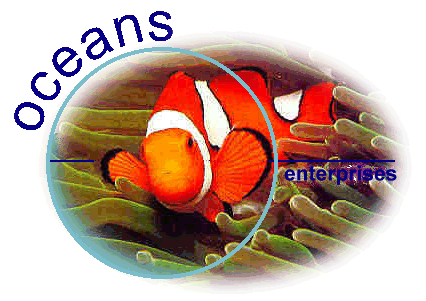|
|
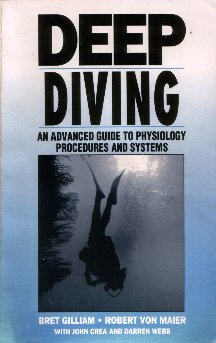 |
DEEP DIVING
Subtitle: An Advanced Guide to Physiology, Procedures
and Systems.
Bret Gilliam and Robert Von Maier
Published by: Watersport Publishing, San Diege, USA in
1992. Revisaed printing 1995. This is just one of a series of excellent
books on diving by this publisher. Later editions of some of the Watersport
publications were published by Aqua Quest Publications of New York.
Card covers with 255 printed pages. Dimensions: 21.5
cms tall by 14 cms wide.
Illustrated with diagrams and monochrome photographs
throughout.
As with all this type of book, the publisher has started
with a disclaimer to cover his back with such a hazardous subject and this
is further re-enforced with a dedication on the next page to “Parker Turner
who lost his life while diving in 1991”. The book is broken down
into 13 chapters, each being a chosen subject for diving deep: “History
of Deep Diving”, “Physiology and Mental Preparation for Deep Diving”, “Stress”,
“Nitrogen Narcosis”, “Oxygen Toxicity”, “Staged Decompression”, “Deep Diving
Equipment and Self Sufficiency”, “Dive Computers and Deep Diving”, “Scientific
Applications of Deep Diving”, “Nitrox”, “An Overview to Mixed Gas”, “Dive
Tables” and “Decompression Sickness, Theory and Treatment”.
Two small appendixes exist with a glossary of diving
terms and the usual bibliography.
[pt],[ps] |
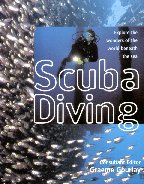 |
SCUBA DIVING
Subtitle: Explore the Wonders of the World Beneath the
Sea.
Consultant Editor: Graeme Gourlay.
Published by: Eagle Editions Ltd, Royston, UK in 2001
Hard back with dust jacket, illustrated boards printed
same as dustjacket. Very well illustrated with many colour photographs
and diagrams; 112 printed pages
Dimensions: 30 cms tall by 22.5 cms wide.
The book is a result of a combined effort from several
contributors. Names acknowledged are Colin Doeg, Steve Warren, Siski
Green, Matt Crowther and
Simon Rogerson, as well as a contribution from Graeme
Gourlay who was “Consultant Editor”. The book is divided into 6 chapters:
1 Introduction to SCUBA.
2 Is SCUBA for me? 3 Equipment. 4 Top Diving Around the
World. 5 Underwater Activities. 6 Aquatic Realm. This isn’t a manual as
such but meant as an aid to training, taking the diver from early steps
through to more advanced SCUBA. [pt],[ps] |
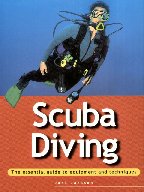 |
SCUBA DIVING
Subtitle: The Essential Guide to Equipment and Techniques
Jack Jackson
Published by: New Holland Publishers, London in 2001.
Hard back with dust jacket, illustrated boards printed same as dustjacket.
Very well illustrated with many colour photographs and diagrams; 96 printed
pages. Dimensions: 27.5 cms tall by 20.5 cms wide
The author is described as an advanced BS-AC diver who
involved in running a sport diving operation in the the Sudanese Red Sea
for twelve years as well as a fellow of the “Royal Geographical Society”
and a member of the British Society of Underwater Photographers (BSoUP).
He has been involved with twelve other books including “Top Dive Sites
of the World” and also a consultant for “The Underwater Photography Handbook”
This seems to be a useful manual although it is not dedicated
to any training organisation. The author mentions recognised scuba
training organisations in the first section. The book is divided into 8
very well illustrated sections: 1 Try It First. 2 The Science of
Diving. 3 Diving and the Body. 4 Equipment. 5 Bacic Training.
6, Sea training and Dive Planning. 7 Safe Diving. 8 Types of
Diving. There is a single appendix in the back, before the index,
that explains “the transfer of heat in water”, “the transfer of light in
water” and “the transfer of line underwater” in more detail. [pt] |
 |
SEA TREK
Martha Holmes
Published by BBC Books London in 1991.
Hard cover with dust jacked and 240 printed pages. Dimensions
25.5 cms tall by 19.5 cms wide. Illustrated throughout with many colour
photographs, some full page.
The book was published to accompany the BBC series of
the same name. The program featured the author (Martha Holmes) and
Mike deGruy in those Lama “fish bowl” type diving helmets. The book
is divided into5 parts to follow the series:
1 The Galapagos Islands. 2 The Californian Kelp
Forest. 3 Australia's Great Barrier Reef . 4 The Carribean
Sea. 5 The Hawaiian Islands
In the series, the presenters used the Lama helmets which
gave them a full 360 degree view and all commentary was made from the presenter
by underwater radio. A wonderful series at the time. [pt] |
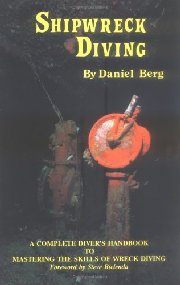 |
SHIPWRECK DIVING
A Complete Diver's Handbook To Mastering the Skills of
Wreck Diving
Daniel Berg
Aqua Explorers, Inc., East Rockaway, N.Y., 1991. Trade
Paperback. (ISBN: 096161675X / 0-9616167-5-X)
Color and B&W Photographs. 8vo - over 7¾"
- 9¾" tall; 88 pages.
Editorial Reviews: Shipwreck Diving is a complete how
to book about the sport of wreck diving. This book is packed with information
and heavily illustrated with over 80 sensational color photographs. Daniel
Berg, a noted wreck diver, instructor and author of ten shipwrecks related
books, describes all the basics of wreck diving. Topics include everything
from equipment modifications, communication, and wreck penetration to artifact
preservation. Dan also tells how to navigate on a wreck and be able to
return to the anchor line after the dive. Why some divers find more artifacts
and explains how to catch lobsters. Shipwreck Diving also covers such diverse
topics as shipwreck research, photography, spear fishing and how to use
an underwater metal detector. This exciting book tells all the tricks of
the trade that untill now have only been learned through years of experience.
Shipwreck divers of all caliber will find Shipwreck Diving informative,
rewarding and entertaining.The author, Dan Berg, has also been the operator
owner and Captain of the local dive boat 'Wreck Valley'. He has lots of
experience in potentially dangerous wreck diving and shares his techniques
here. |

.
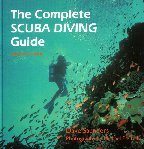 |
THE COMPLETE SCUBA DIVING GUIDE
Dave Saunders. Photography by Mike Portelly
Published by: A&C Black London in 1987.
First edition:Hard printed cover and 144 printed pages.
Although a “guide” and not a diving manual as such, the
book takes the reader through the stages of learning to dive and beyond
in 1987. It is split into 9 parts:
1 How Diving Developed. 2 Equipment. 3 Physical
Laws and Their Effects on Divers. 4 Pool Training. 5 First
Open Water Dive. 6 Completing Basic Training.
7 Types of Dive. 8 Associated Skills
9 Diving Around the World.
As you would expect with photography by the award winning
underwater photographer Mike Portelly, the photos, drawings and illustrations
are excellent. [pt]
THE COMPLETE SCUBA DIVING GUIDE
Dave Saunders, Photographs by Michael Portelly.
Second Edition, published by: A & C Black, London,
UK, 1994.
Hard covers with 136 printed pages. dimensions: 20.5
cms tall by 19.5 cms wide.
As you would expect with anything photographed by Michael
Portelly, the coloured and monochrome photographs are all excellent.
This guide is quite a comprehensive manual that should have been quite
useful as an aide memoir for any training organisation. It is divided
into 9 sections, ranging from diving history, training and world wide diving:
“How Diving Developed”, “Equipment”, “Physical Laws and
Their Effects on Divers”, “Pool Training”, “First Open-Water Dive”, “Completing
Basic Training”, “Types of Dive”. “associated Skills” and “Diving around
the World”. Although very oriented to the British Sub-Aqua Club (lots of
the line drawings and decompression tables are taken from the BS-AC system),
the author has included a section at the back of “Useful Addresses”, as
well as the BS-AC, it includes CMAS, NAUI, PADI, SSI and the rival British
organisation called the Sub Aqua Association (SAA). [pt] |
 |
THE DIVERS HANDBOOK
Alan Mountain
Published by New Holland Publishers, London in 1996.
Illustrated card covers with160 printed pages. Very well
illustrated with many colour photographs. Dimensions: 28 cms tall by 21.5
cms wide
Written in 9 chapters, this book is intended as a manual
and guide to diving equipment. It states that it is a guide to which
training courses are available, mentioning PADI, the British Sub-Aqua Club
(BSAC) and NAUI. Chapters in the book are set out as follows:
A Brief History of Diving, The Natural Laws of Diving,
Equipment, Training, Health and Safety, The Sea and its Many Moods, Reefs
and Their Fascination, Dangerous Marine Organisms and Diversify Your Diving.
In the back of the book is a useful glossary of terms and acronyms. In
all, quite a good, useful guide as some of the subjects covered are not
included in the basic training manuals – they are always at extra cost
these days! [pt]
My comment: This is an exceptionally well produced book,
full of colour on virtually every page, and gives a great background to
sport diving. Although not an instruction book, it is nevertheless a
book full of detail and educational material. Chapters as above - and an
excellent chapter on various types of diving and diving activities. Would
make a brillliant gift to any diver, be they a novice or experienced.
Interesting reading and well worth having. [ps] |
 |
THE DIVER'S UNIVERSE
Subtitle: A Guide to Interacting With Marine Life
Annemarie & Danja Kohler
Published by New Holland Publishers, London, 1997. And
in 2003.
Illustrated card covers with160 printed pages. Very well
illustrated with many colour photographs. Dimensions: 28 cms tall by 21.5
cms wide.
Written in the same series as “The Divers Handbook” from
the same publisher, the book covers the marine life the diver is likely
to encounter in the tropics, maybe the authors didn’t like diving in cold
water? The book is split into 5 chapters: Life Beneath the Surface,
Seeking the Sea’s Creatures, Habitats and Homes, Small Worlds of the Blue
Universe and finally Mankind and the Marine Environment. The authors
claim the book includes around 200 colour photographs of fish and many
fact panels plus fascinating anecdotes drawn from the authors years of
experiences (in warm water that is).[pt] |
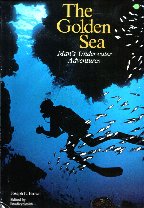 |
THE GOLDEN SEA
Joseph E Brown
Subtitle: Man’s Underwater Adventures.
Edited by Bradley Smith
Published by: Cassell & Company Ltd, London in 1974.
(Printed and bound in the USA)
Hard back with blue boards and dust jacket, 214 printed
pages. Dimensions: 32.5 cms tall by 21.5 cms wide.
This book is described as not being about the creatures
under the sea but the extent of mans involvement under the sea. It
covers mans involvement exploring, mapping, charting, farming, cleansing,
policing, discovering and befriending the wonders of the sea. It
is divided into 13 chapters: The Dark Sea, The Dangerous Sea, Danger, Cameras
Underwater, The Unseen Sea, The Golden Sea, The Drowned Cities, The Sea
of Submerged Civilisations, The Sea of Lost Ships, The Treasure Ships,
The Sea and Survival, The Tomorrow Sea and finally The Challenge of the
Sea. The book is well illustrated with many colour photos and diagrams,
some full page. [pt], [ps] |
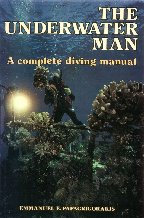 |
THE UNDERWATER MAN - A Complete Diving
Manual
Emmanuel E Papagrigorakis.
Translated by Philip Ramp – presumably from Greek?
Published by: Dymock’s Book Arcade, Sydney in 1980. Illustrated
hard cover with matching dust-jacket; 334 printed pages.
It says that the aim of the book is to describe simply
and clearly the mechanics of diving with and without the use of breathing
apparatus. It is divided into twelve chapters covering a lot of subjects:
“Introduction to Diving”, “Physics of Diving”, “Physiology and Anatomy
of Diving”, “Problems and Dangers of Diving”, “Diving Equipment”, “Dangerous
Situations”, “Dangerous Inhabitants of the Underwater World”, “General
Safety Measures”, “The Dive”, “Free Diving or Snorkeling”, “Spearfishing”
and “Training, Maintenance and Organisation of the Diver”. Extremely well
illustrated with colour and monochrome photographs along with many excellent
line drawings. The section on diving equipment is extremely well
illustrated with all manner of equipment shown however for 1980, the content
seems a bit dated as there is an aweful lot of twin hoses about (as there
is throughout the book) and only a US Divers Calypso single hose photographed.
On the other hand, it does show re-breathers! Seems to be a totally
independent book as it makes no reference to any training organisations
just that some are developed in certain countries. [pt]
PS comment: Being an Australian publisher, it could be
assumed that author Papagrigorakis was an Aussie diver but not so; with
respect, I have not heard of him and the material in the book gives no
indication that it is parochial to Australia - and if he was an Aussie
he would not need an interpreter, obviously. I suggest that Dymock's have
picked up the Australian rights from a European publisher - but I have
never come across a European edition of the book. No doubt there is a Greek
edition. If this is what has happened, Dymock's Book Arcade did not do
their market research too well, nor did they examine the manuscript with
any diving knowledge; at the time, as is now, independent 'how to dive'
books are not popular sellers in Australia as the certified diving agencies
such as PADI provide their own manuals for certified instruction. I never
stocked the book with Oceans Enterprises as I thought it would never sell.
I think I was right. |
|
|
